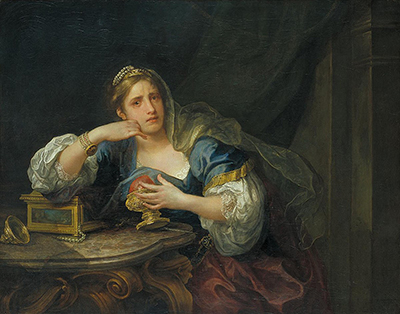Sigismunda Mourning over the Heart of Guiscardo is an oil painting by a British artist called William Hogarth. This piece was made in 1759 and was a key among the paintings he presented at an exhibition in 1761.
William was a historical painter who played with multiple styles to pass various messages to his viewers. This painting is not different as he picks a moment in Boccaccio's Decameron's book. William desired to position himself as a dramatic scenery painter with this piece. However, it was received with some criticism, although later appreciated decades after it was released. The painting depicts a scene in the first tale on the fourth day of the Decameron. This was a collection of short stories from a medieval Italian poet and author called Giovanni Boccaccio. The piece shows a woman seated and leaning to an ornate wooden table (delicate styling on the top and legs is visible).
This woman is called Sigismunda (in the story, she goes by the name Ghismonda) and wears a flowing silk dress and a pearl tiara. She holds a golden goblet close to her chest. This goblet contains the heart of her murdered husband. In the novel, the writer had made her a heroine of the story. On the painting, Hogarth modelled her to represent his wife, Jane.
Giscardois a middle-class servant in the court of Prince Tancred of Salerno, who happens to be Sigismunda's father. When the prince discovers that the two love birds had secretly wedded, he sends his men to murder Guiscardo and deliver his heart in a golden goblet to Sigismunda. From the turn of events, Sigismunda commits to die without shedding a tear. However, she is overwhelmed by the pain of losing her husband and ends up weeping. Later on, she adds poison to the cup that contains the heart of her late husband and drinks it to her death. William Hogarth had long been interested in this story that appeared in various versions across England for much of the 18th century. The story gained prominence when it was translated from Italian to English and published in John Dryden's Fables, Ancient and Modern in 1669.
Although it lacked mythology or the supernatural element, like most paintings of a similar style, this piece was a neoclassic piece of art. It has a dramatic light and a clean style. The primary colours are bright and objects have bold edges. All these are hallmarks of this style of art. It was also the best way to present a piece of a story that happens in history.




